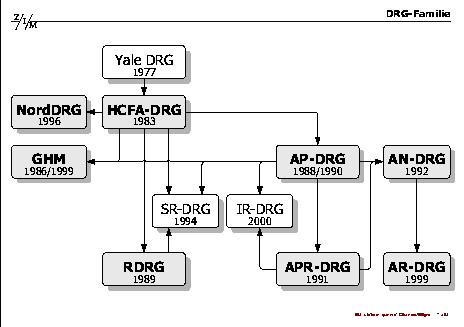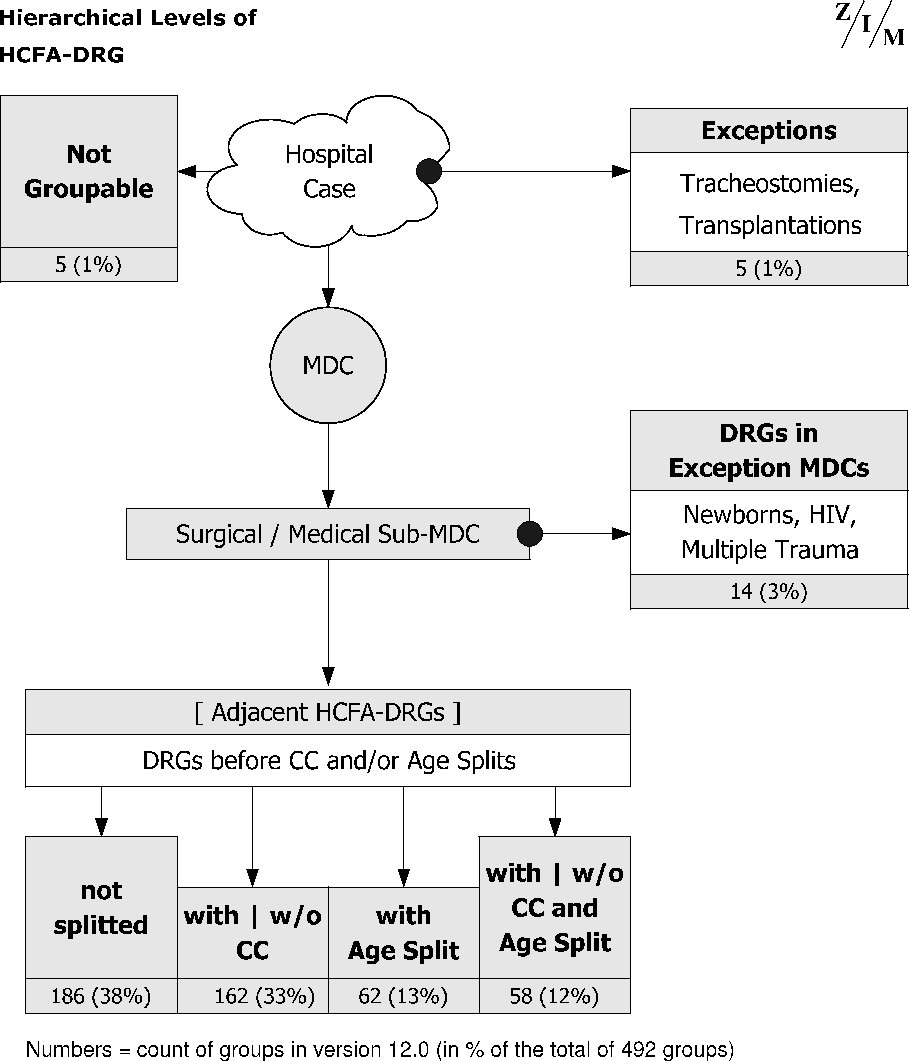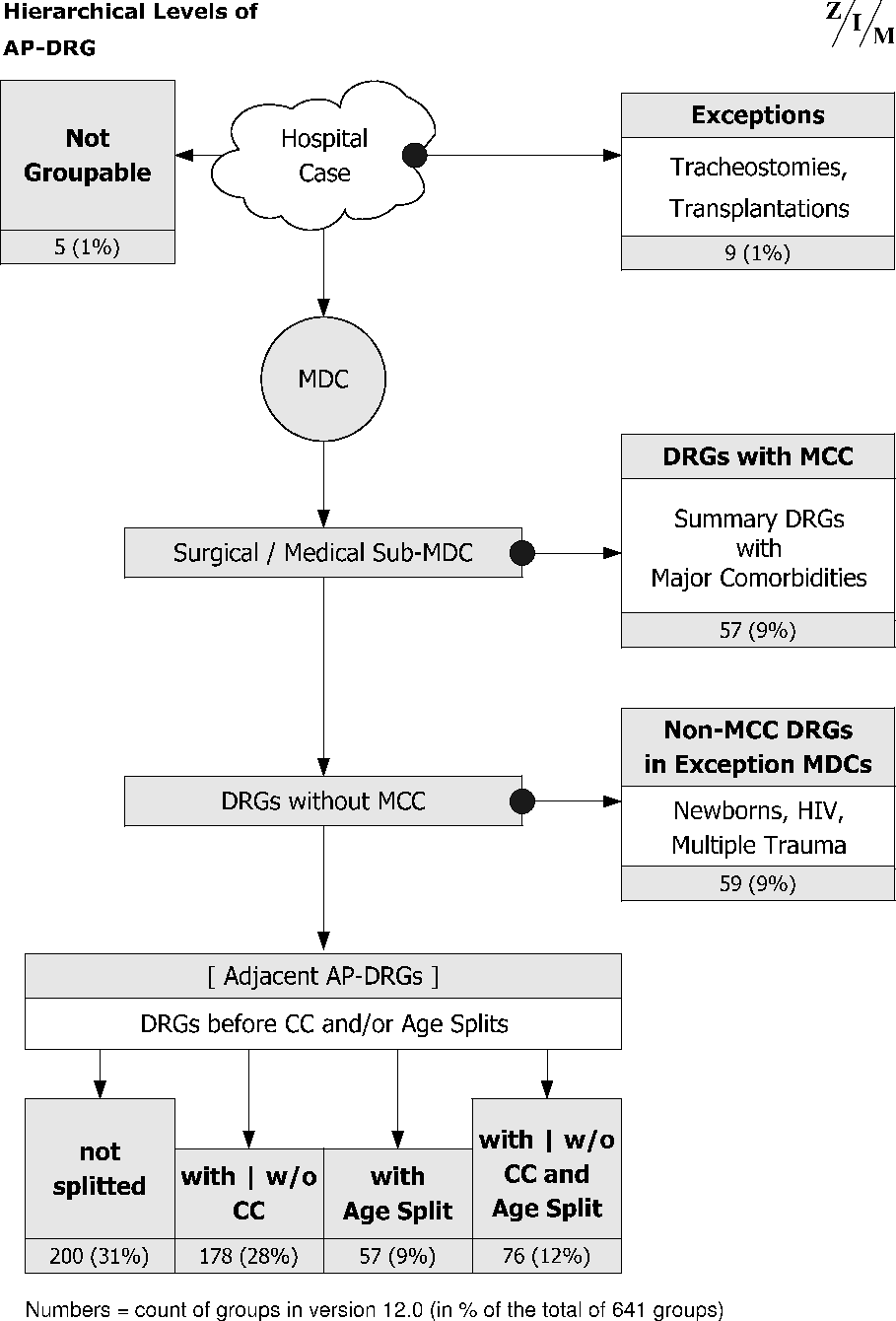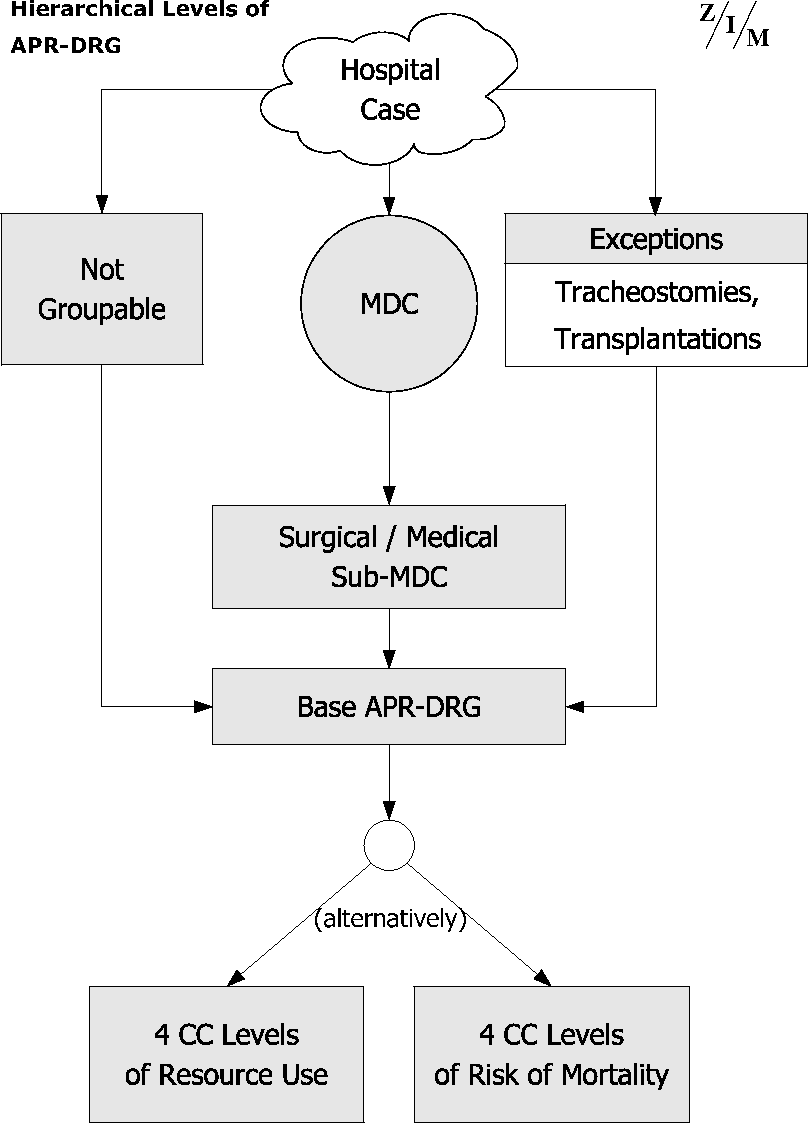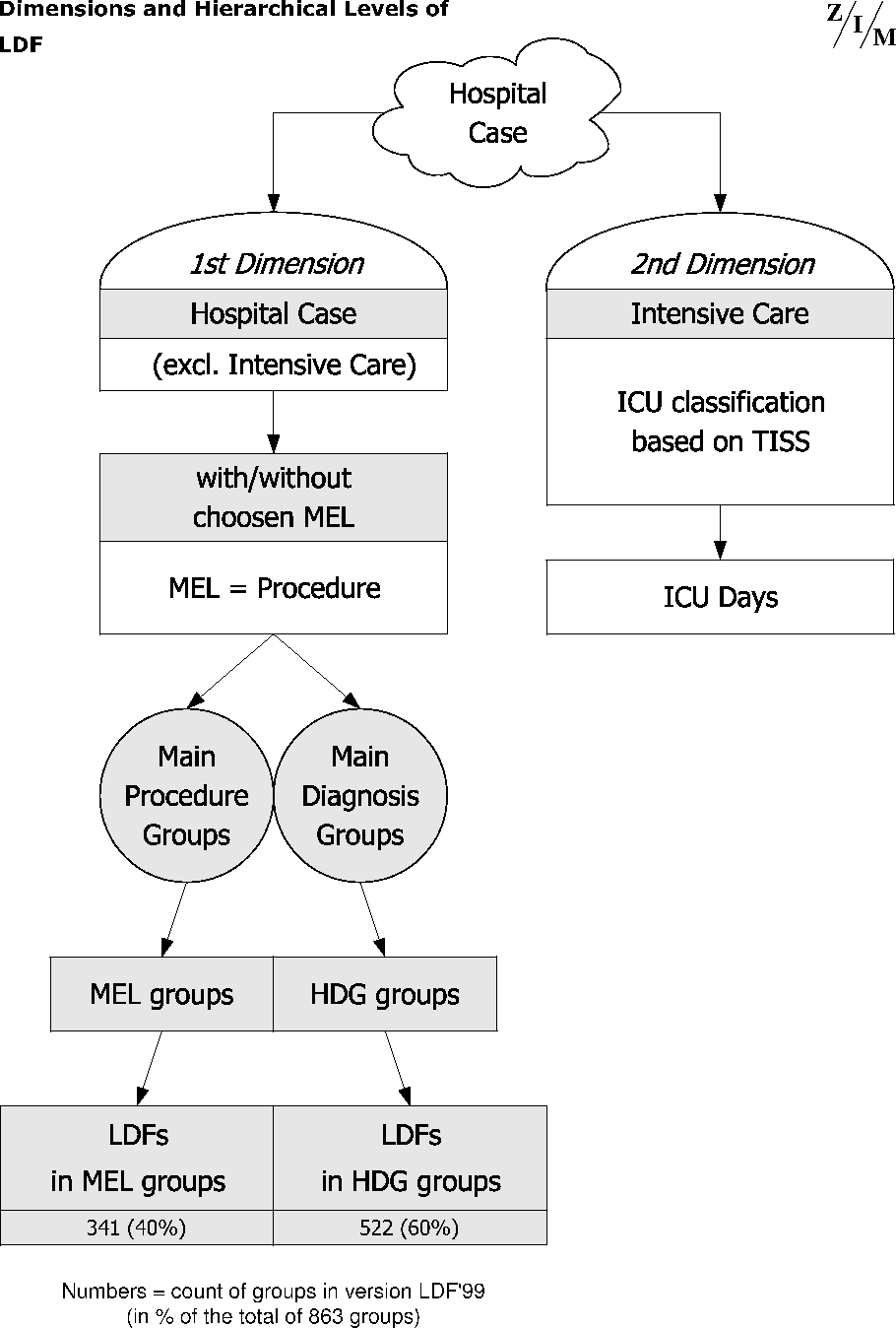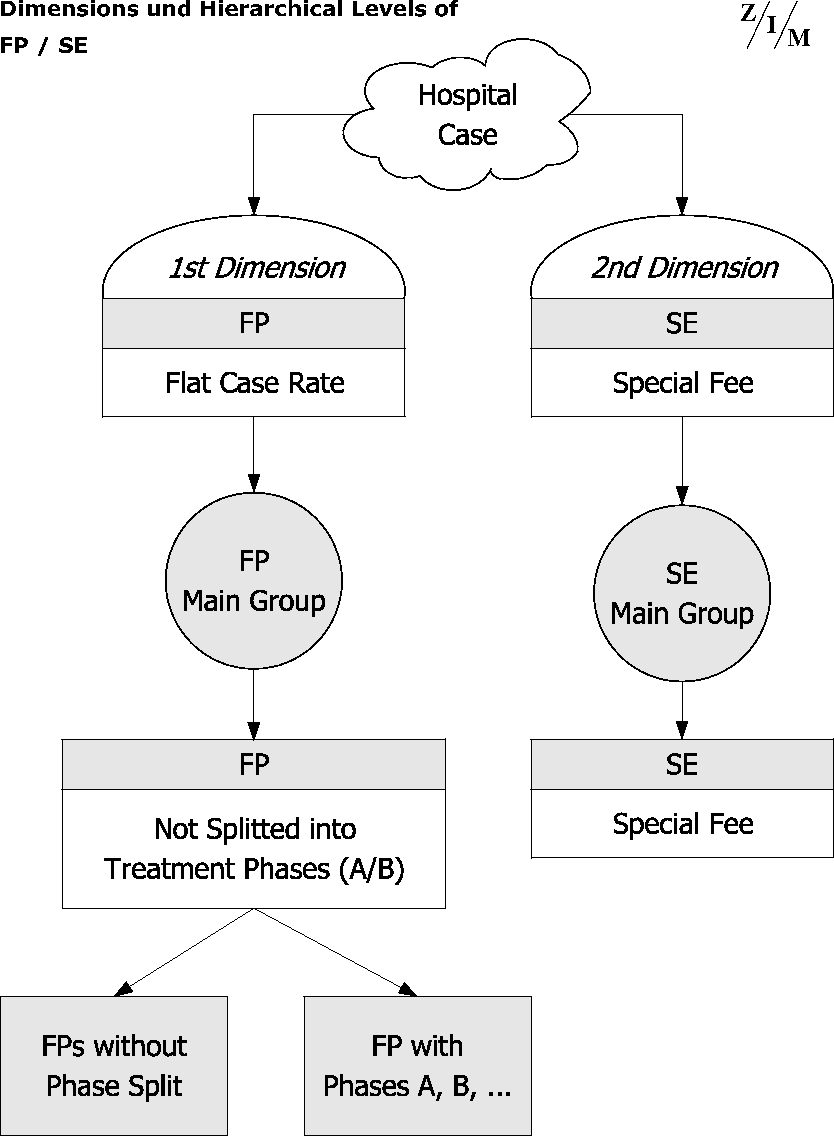Fischer:
A Comparison of PCS Construction Principles of the American DRGs, the Austrian LDF System, and the German FP/SE System.
|
Z I M
- Paper 15th PCS/E Odense
|
Sept. 1999
Last update: 31.01.2000
|
| ·
< ·
× ·
> ·
|
ABSTRACT
-
INTRODUCTION
-
DRG systems are the best-known PCSs.
In some countries one of the DRG systems was adapted;
other countries preferred to build new systems
using similar construction principles.
-
METHODS/MATERIAL
-
For an expert opinion - commissioned by the
German Hospital Association -
the DRG systems HCFA-DRG, AP-DRG
and APR-DRG were compared with the two
German-language PCSs: the Austrian LDF system
and the German system of "Fallpauschalen" and "Sonderentgelte"
(FP/SE: Flat Case Rates and Special Fees for O.R. procedures).
-
RESULTS
-
-
Construction principles
-
Although DRG systems present a one-dimensional
structure with a simple hierarchy, their
construction actually involves multiple hierarchies.
The LDF system uses a two-dimensional approach
with diagnosis groups for hospital cases and ICU
groups for ICU days. The structure of the FP/SE
system is also two-dimensional. -
The use of doctors' criteria alone and the
use of main diagnoses in all systems weakens the
homogeneity of the resulting groups throughout.
A further important source of inhomogeneity are blurred
definitions of "hospital case".
-
Contents
-
While DRGs and LDFs cover the whole spectrum of
acute care inpatient patients, FP/SE cover only
a part of all hospital cases. -
While LDFs are nearer to ICD codes and therefore
more easily understandable, DRGs have found a more
sophisticated way of dealing with multimorbidity. -
None of the systems is really capable of
reflecting clinical severity.
-
Cost weights and further figures . . .
-
... such as average length of
stay (ALOS) or trim points should be developed
from scratch in each individual country.
-
CONCLUSIONS
-
-
The use of doctors' criteria alone, the
requirement of main diagnoses, and the lack of
an adequate definition of the term "hospital case"
result in a lack of homogeneity.
-
PCSs do not have
to be adapted as a whole. Whereas it can be
useful to adapt the PCS groups and perhaps some algorithms
to calculate figures (such as weights or trim points), it is
problematic to take over the figures themselves.
-
The use of a PCS also requires the creation of a whole set of
surrounding components of the remuneration system.
| ·
< ·
× ·
> ·
|
INTRODUCTION
DRG systems [1] [2]
have won the competition as the most widely accepted and
best-known PCS. There are three developments which can be observed
(cf. also: http:// www.fischer-zim.ch / notes-en / PCS-in-Europe-9810.htm):
-
Many countries have created adaptations of one of the
DRG systems.
-
3M, the producer of DRG systems, has itself developed
several variants of DRG systems.
-
In some countries, newly built systems which use similar
construction principles have evolved.
The development of DRG systems began at Yale University (R. Fetter)
in the USA in the late 1980s in competition with other systems such as
D.S. and PMC.
The first aim was to use this patient classification system (PCS) for
quality assurance. Medicare, the government health insurance of
elderly, which is administered by HCFA, began to use DRGs as part
of a prospective payment system in 1983. Other insurance companies called
for patient groups for all types of patients, which entailed the development
of AP-DRGs and APR-DRGs by 3M, and RDRGs by the group of R. Fetter. In 1994,
HCFA published SR-DRGs as a refined version of
HCFA-DRGs. Major comorbidities and complications (MCCs) were introduced at
DRG level. This system has not been used for remuneration so far because
it has been feared that it would cause payment shifts between the hospitals
(cf. table 1).
At this 1999 PCS/E conference in Odense, 3M presented
the IAP-DRG system (International All Patient Diagnosis Related Groups),
which will be finished by the end of 1999. It is an abridged
version of the APR-DRG system: It has 3 CC levels (instead of 4)
and a total number of 1,046 groups.
Table
1:
The Extended Family of DRG Systems
(Figures = Year of first implementation)
In Austria, DRGs were evaluated from 1985 to 1987. In 1997,
a home-grown PCS called LDF1 was introduced
throughout the whole country as part of a remuneration system named
LKF.2
The first approaches towards these systems began in 1988. In 1995 and 1996,
pilot trials were conducted in two provinces (in Vorarlberg and
in Lower Austria).
The LDF system is revised each year.
The third version of LDFs for 1999 defines 848 LDFs.
The cost weights date from the case calculations of 1989, 1991 and
1993. A revision of the calculation of the cost weights is imminent.
[3]
1
LDF = performance-related diagnostic case groups
("Leistungsbezogene Diagnose-Fallgruppen").
2
LKF = performance-oriented financing of hospitals
("Leistungsorientierte Krankenanstalten-Finanzierung").
In Germany, DRGs were evaluated and rejected in 1986. It was
found that multimorbidity and severity were not adequately considered and
that the variance displayed when using groups from the 3 first digits of
ICD-9 was more or less the same as with DRGs. Then, PMCs
were translated and evaluated by Prof. G. Neubauer. [4]
[5]
In 1995, the German-developed system of "Fallpauschalen" and
"Sonderentgelte" ("FP/SE": Flat Case Rates and Special Fees) was
introduced by the government. With 94 FPs and 146 SEs, only a part
of all hospital cases are covered. In 1998, the decision-making was
delegated to the umbrella associations of insurers and
of hospitals. (This is called "self-administration".)
The discussion now focuses on the alternatives of either
the further development of the FP/SE system
or the introduction or adaptation of one of the DRG systems,
or the introduction of the Austrian LDF system.
| ·
< ·
× ·
> ·
|
METHODS/MATERIAL
In this paper, the author presents the main themes of a book of his which
contains the revision and extension of an
expert opinion commissioned by the
German Hospital Association. [6]
The DRG systems HCFA-DRG,
AP-DRG and APR-DRG are compared with the two
German-language PCSs: the Austrian LDF system, which
has been newly developed [3]
and the German system of "Fallpauschalen" and "Sonderentgelte"
(FP/SE: Flat Case Rates and Special Fees).
[7] [8]
A comparison grid was developed which includes the main
points which should be discussed in an evaluation of patient classification
systems. It was structured according to the following items:
- PCS construction principles
- PCS contents
- PCS application
- possibilities of utilisation
| ·
< ·
× ·
> ·
|
RESULTS
PCS construction principles
-
Dimensionality
-
Although DRG systems present a one-dimensional structure with
a simple hierarchy, their construction actually involves multiple
hierarchies.
A special case is the MCC concept of
AP-DRGs, which causes problems when grouping results of this system
are to be compared to results of one of the other DRG systems
(cf. table 2-4).
The LDF system shows a more consistent
hierarchical structure.
Beyond, it uses the classification of treatment in intensive
care units (ICUs) as a second dimension of LDF
(cf. table 5).
The FP/SE also has two dimensions. They are used for the main
treatment and - in case of surgical treatment - for additional
operation room procedures
(cf. table 6).
Table
2:
Hierarchical Levels of HCFA-DRGs
Table
3:
Hierarchical Levels of AP-DRGs
Table
4:
Hierarchical Levels of APR-DRGs
Table
5:
Hierarchical Levels of the
Austrian LDF System
Table
6:
Hierarchical Levels of the
German FP/SE System
-
Classification criteria
-
The use of doctors' criteria alone and
the use of main diagnoses in all systems
weakens the homogeneity of the resulting groups throughout
(cf. tables 7 to 12).
To point out the importance of additional criteria, we can have
a look at other settings: it makes no sense, for instance, to
define minimal datasets which contain only diagnoses in settings
like rehabilitation, geriatry or psychiatry.
In acute care, there are always elderly people or people with
disabilities, which results in higher costs. Therefore it is essential
to ask about the reasons for inhomogeneity in acute care, too.
The LDF system uses an ICU score per day based on TISS
as additional classification criterion.
For this criterion, a second grouping dimension was constructed
(cf. table 3 above).
The FP/SE system uses some discharge types for cardiac and
orthopaedic cases as grouping criteria:
- Acute care until the wound is healed.
- Acute care until the patient can be discharged to rehabilitation.
- Acute care until the patient is discharged into acute geriatry
(also before the wound is healed).
In the FP/SE system, different cost weights are used according to
whether a patient is treated by a hospital doctor or by a doctor
from outside the hospital who only uses its infrastructure. (The
costs of doctors are included in the German Flat Case Rates, in
contrast to the American way where cost weights are calculated
without doctors' costs.)
None of the systems uses information about treatment goals.
| Variant |
ICD-9-CM |
Main Diagnosis |
Secondary Diagnosis |
Additional Secondary Diagnosis |
| (a) |
250.00 |
Diabetes m. |
Pneumonia |
Septicaemia |
| (b) |
486 |
Pneumonia |
Diabetes m. |
Septicaemia |
| (c) |
038.9 |
Septicaemia |
Pneumonia |
Diabetes m. |
Table
7:
Coding Choices of an Example Case [9]
| Variant |
MDC |
HCFA-DRG |
Cost Weight |
HCFA-DRG Label |
AP-DRG |
Cost Weight |
AP-DRG Label |
| (a) |
10 |
294 |
(0.75) |
Diabetes
Age > 35 |
566 |
(2.62) |
Endocrine, Nutritional and Metabolic Disorder
Except Eating Disorder or CF with Major CC |
| (b) |
4 |
89 |
(1.19) |
Simple Pneumonia and Pleurisy
Age > 17
with CC |
541 |
(2.46) |
Respiratory Disorder except Infections, Bronchitis, Asthma with Major CC |
| (c) |
18 |
416 |
(1.53) |
Septicaemia
Age > 17 |
584 |
(3.98) |
Septicaemia with Major CC |
Table
8:
DRGs and Cost Weights of the Example Case
| Variant |
LDF |
Points |
Label of LDF |
FP/SE |
| (a) |
HDG 18.05 A |
(28,779) |
Diseases of the Pancreas |
- |
| (b) |
HDG 05.03 B |
(44,499) |
Pneumonia and Bronchiolitis with Bronchoscopy |
- |
| HDG 05.03 C |
(35,298) |
Pneumonia and Bronchiolitis
without Bronchoscopy Age > 69 |
| (c) |
HDG 16.05 B |
(41,403) |
Complicated Bacterial Infection
with Main Diagnoses 038 (Septicaemia) |
- |
Table
9:
LDF and FP/SE Groups of the Example Case
| HCFA-DRG Cost Weights |
0.75 |
1.19 |
1.53 |
| (a) |
(b) |
(c) |
| DRG 294 |
0.75 |
(a) |
|
159% |
204% |
| DRG 89 |
1.19 |
(b) |
63% |
|
129% |
| DRG 416 |
1.53 |
(c) |
49% |
78% |
|
Table
10:
HCFA-DRG Cost Weight Proportions
| AP-DRG Cost Weights |
2.62 |
2.46 |
3.98 |
| (a) |
(b) |
(c) |
| DRG 566 |
2.62 |
(a) |
|
94% |
152% |
| DRG 541 |
2.46 |
(b) |
107% |
|
162% |
| DRG 584 |
3.96 |
(c) |
66% |
62% |
|
Table
11:
AP-DRG Cost Weight Proportions
| LDF Cost Weights |
28,779 |
44,499 |
35,298 |
41,403 |
| (a) |
(b1) |
(b2) |
(c) |
| HDG 18.05 A |
28,779 |
(a) |
|
155% |
123% |
144% |
| HDG 05.03 B |
44,499 |
(b1) |
65% |
|
79% |
93% |
| HDG 05.03 C |
35,298 |
(b2) |
82% |
126% |
|
117% |
| HDG 16.05 B |
41,403 |
(c) |
70% |
107% |
85% |
|
Table
12:
LDF Cost Weight Proportions
-
Temporal units
-
While the definition of "hospital case"
does not seem to be an explicit part of DRG systems,
there are some first trials to cover this important subject in the
FP/SE system: some groups are split according to treatment phases
defined by the type of discharge (as mentioned above).
But instead of the integration of this temporal dimension into
the hierarchy of the PCS groups, it would be more flexible to create
a separate dimension for it.
PCS contents
-
Coverage
-
All DRG systems (with 500 to 1500 groups)
and the LDF system (with 863 LDFs)
cover the whole spectrum of acute care inpatient patients.
The FP/SE system (with 94 FPs and 146 SEs) covers only part of all
hospital cases. In 1996, 34% of the inpatient cases were remunerated
through flat case rates (i.e. 21% of inpatient days or 23%
of turnover). In some fields, higher proportions were
achieved; for instance, 80% in cardiac surgery.
-
Clinical Homogeneity
-
LDFs are defined rather straightforwardly by the ICD codes.
Therefore they are more easily understandable than DRGs, which
are defined by decision trees.
DRGs have found a more sophisticated way of dealing with multimorbidity
when splitting case groups into subgroups with and without CCs
(comorbidities or complications) and/or MCCs (Major CCs).
None of the systems is really capable of reflecting clinical severity
of the illness. (Multimorbidity is only one facet of severity.)
The information needed is already lacking in the minimal data
set that is used.
It would be interesting to conduct the following test: doctors
who have worked with a PCS for a sufficiently long period of time
should classify their patients without using the grouper software.
The difference between manual grouping and grouping by
software would show the degree to which patient groups correspond
with clinical thinking.
Cost weights and further figures
-
-
As I showed at a previous PCS/E conference,
cost weights
and further figures such as average length of
stay (ALOS) or trim points are rather specific
for each individual country. [10]
It is recommended that "figures components" of any
PCS which was developed abroad should not be adopted.
Integrating a PCS into a remuneration system
-
-
A PCS is not a remuneration system.
Many additional components have to be defined (cf. table 13):
- the setting,
- the funding model on which the remunerations system will be based,
- the hospital product types which should be covered,
- the scope of the regulations,
- the payment components,
- figures as cost weights, average length of stays, trim points,
- modalities of outlier payments,
- patient categories including a description of the service bundles to be delivered,
- temporal units, e.g. "hospital case".
The Austrian hospital financing system LKF,
of which LDF is a part, is a good example to show which
elements have to be defined for the integration into
a remuneration system.
Remuneration System
for Inpatient Treatment
|
|
|
Setting:
- inpatient treatment
- inpatient+outpatient
- treatment episodes (inpat.+amb.)
- . . .
|
Funding Model:
- one/more financial sources
- budgeting/caps
- with/without deficit compensation
- . . .
|
R e m u n e r a t i o n M o d e l
Health Care Product Types:
- treatment
- others
|
Scope of Regulations:
- nation
- region
- group of hospitals
- one hospital
|
Payment Components:
- basic payments
- modifications
|
|
|
|
|
" P r i c e L i s t "
|
Product Description
|
Prices
|
Service Bundles:
- patient
categories
|
Units:
- "case"
|
Characteristics:
- ??
|
Figures:
- cost weights
- length of stays
- trimpoints
|
Payments:
- fixed payments
per case
- outlier payments
|
|
|
|
|
|
| PCS Constructions Principles
| |
|
| |
|
|
|
|
|
|
Calculations Methods
(cost weights, length of stays, ...)
| |
|
| |
|
|
|---|
Table
13:
General Remuneration System for "Inpatient Treatment"
| ·
< ·
× ·
> ·
|
EVALUATION
In the table 14, several aspects of PCSs are compared.
The following scale was used:
1 = bad,
2 = unsatisfactory,
3 = moderate,
4 = good,
5 = very good.
| Construction |
FP/SE |
LDF |
HCFA-DRG |
SR-DRG |
AP-DRG |
APR-DRG |
| Separability of the PCS elements: grouping structure /
algorithms to calculate figures (e.g. cost weights) /
value of the figures |
5 |
5 |
5 |
5 |
5 |
5 |
| Clear hierarchies / possibilities for aggregations |
3- |
-4 |
3-4 |
-4 |
2-3 |
4 |
| Multimorbidity |
1-2 |
2 |
2-3 |
3 |
3 |
-4 |
| Possibility of constructing clinical pathways |
4 |
3-4 |
3 |
3-4 |
-3 |
3-4 |
| Transparency of the building process of the groups |
5 |
4-5 |
3 |
3 |
3 |
2 |
| Adequate definition of the "case" |
2 |
1 |
1 |
1 |
1 |
1 |
| Contents |
FP/SE |
LDF |
HCFA-DRG |
SR-DRG |
AP-DRG |
APR-DRG |
| Applicability in acute inpatient care |
4 |
4 |
4 |
4 |
4 |
4 |
| Applicability to other settings |
1 |
1-2 |
1 |
1 |
1 |
1 |
| Completeness |
2 |
5 |
5 |
5 |
5 |
5 |
| Degree of graduation |
4 |
3 |
3 |
3-4 |
3-4 |
4 |
| Clinical homogeneity |
3-4 |
3-4 |
2-3 |
2-3 |
2-3 |
3-4 |
| Homogeneity of costs |
3-4? |
2-3? |
2-3 |
3 |
3 |
3-4 |
| Application |
FP/SE |
LDF |
HCFA-DRG |
SR-DRG |
AP-DRG |
APR-DRG |
| Error tolerance related to coding variants |
1 |
2 |
3 |
3 |
3 |
3 |
| Error tolerance related to incomplete coding |
5 |
4 |
3 |
2-3 |
2-3 |
2 |
| Acceptance of doctors |
3-4 |
3-4 |
3 |
3-4 |
3-4 |
4-5 |
| Acceptance of nurses |
2 |
2 |
2 |
2 |
2 |
2 |
| Acceptance of economists |
3 |
4 |
4-5 |
4 |
4 |
3-4 |
| Maintenance secured |
2 |
3-4 |
5 |
1 |
4-5 |
3-4 |
| Possibilities of utilisation |
FP/SE |
LDF |
HCFA-DRG |
SR-DRG |
AP-DRG |
APR-DRG |
| Calculation of costs of cases |
4 |
3 |
3 |
3-4 |
3-4 |
4 |
| Remuneration |
3-4 |
4 |
4 |
4 |
4 |
3-4 |
| Business management |
2 |
4 |
4 |
4 |
4 |
4 |
| Clinical management |
3 |
4 |
3 |
4 |
4 |
4-5 |
| Performance declaration |
2 |
5 |
5 |
5 |
5 |
5 |
| Benchmarking |
2-3 |
3-4 |
3-4 |
4 |
4 |
4-5 |
| Performance contracts |
1 |
4 |
4 |
4 |
4 |
4-5 |
| Planning of hospitals |
2 |
5 |
5 |
4 |
4 |
4 |
| Epidemiological research |
2 |
3 |
3 |
3 |
3 |
3-4 |
Table
14:
Comparative PCS Evaluation
| ·
< ·
× ·
> ·
|
CONCLUSIONS
-
The use of alone doctors' criteria, the requirement
of main diagnoses, and the lack of an adequate definition of the
concept "hospital case" result in lack of homogeneity.
-
PCSs do not have
to be adapted as a whole. While it can be
useful to adapt the PCS groups and perhaps some algorithms
to calculate figures (such as weights or trim points), it is
problematic to take over the figures themselves.
-
The use of a PCS also requires the creation of a whole set of
surrounding components of the remuneration system.
| ·
< ·
× ·
> ·
|
REFERENCES
[1]
Fetter RB, Brand A, Dianne G [Eds.]:
DRGs, Their Design and Development.
Health Administration Press, Ann Arbor 1991: 341 pp.
[2]
Averill RF, Muldoon JH, Vertrees JC, Goldfield NI,
Mullin RL, Fineran EC, Zhang MZ, Steinbeck B, Grant T:
The Evolution of Case Mix Measurement
Using Diagnosis Related Groups (DRGs).
3M HIS Working Paper 5-98. Wallingford 1998 (3M): 40 pp.
[3]
BMAGS-A:
Bundesministerium für Arbeit, Gesundheit und Soziales:
Leistungsorientierte Krankenanstaltenfinanzierung - LKF - Modell 1999.
Wien 1998 (BMAGS): 28 pp.
Internet: http:// www.bmg.gv.at / home / Schwerpunkte / Krankenanstalten /.
[4]
Neubauer G, Demmler G, Eberhard G, Rehermann P:
Erprobung der Fallklassifikation "Patient Management Categories"
für Krankenhauspatienten; Ergebnisbericht.
Baden-Baden 1992 (Nomos): ca. 360 pp.
[5]
Neubauer G, Demmler G, Eberhard G:
Erprobung der Fallklassifikation "Patient Management Categories"
für Krankenhauspatienten; Anlagenbericht: Klinische
Überprüfung der Plausibilität für die Bundesrepublik
Deutschland.
Baden-Baden 1992 (Nomos): 356 pp.
[6]
Fischer W:
Diagnosis Related Groups (DRGs) im Vergleich zu den Patientenklassifkationssystemen von Österreich und Deutschland
(A Comparison of PCS Construction Principles of the American DRGs, the Austrian LDF System, and the German FP/SE System).
Z/I/M, Wolfertswil 1999: 155 pp.
Internet: http:// www.fischer-zim.ch / studien / DRGs-im-Vergleich-9901-Info.htm.
[7]
Eichhorn S, Neubauer G; Baugut G, Philippi M, Rehermann P:
Leitfaden zur Einführung von Fallpauschalen und Sonderentgelten
gemäss Bundespflegesatzverordnung 1995.
Datenbedarf, Kalkulationsgrundlagen, Abrechnungsmodalitäten,
Kostenausgliederung.
Baden-Baden 1995 (Nomos): 210 pp.
[8]
BMG-D:
Bundesministerium für Gesundheit [Hrsg.]:
Gutachten Weiterentwicklung der Fallpauschalen und Sonderentgelte nach
der Bundespflegesatzverordnung: Bericht zu den Forschungsprojekten im
Auftrag des Bundesministeriums für Gesundheit.
Baden-Baden 1997 (Nomos).
[9]
Steinum O:
A Correct DRG Allocation Presupposes Correct Diagnoses.
In: Proceedings of the 11th PCS/E International Working Conference.
Oslo, 1995: 43-48.
[10]
Fischer W:
Comparison of Cost Weight Proportions of Different Patient Classification Systems.
In: Proceedings of the 13th PCS/E International Working Conference.
Florence, 1997: 230-234.
Internet: http:// www.fischer-zim.ch / paper-en / Cost-Weights-9710-PCSE.htm.
| ·
< ·
× ·
> ·
|
© Z I M
Source =
http://www.fischer-zim.ch/paper-en/PCS-Comparison-9909-PCSE.htm
( latest compilation:
28.06.2013
)
 DRGs im Vergleich mit LDF und FP/SE
DRGs im Vergleich mit LDF und FP/SE